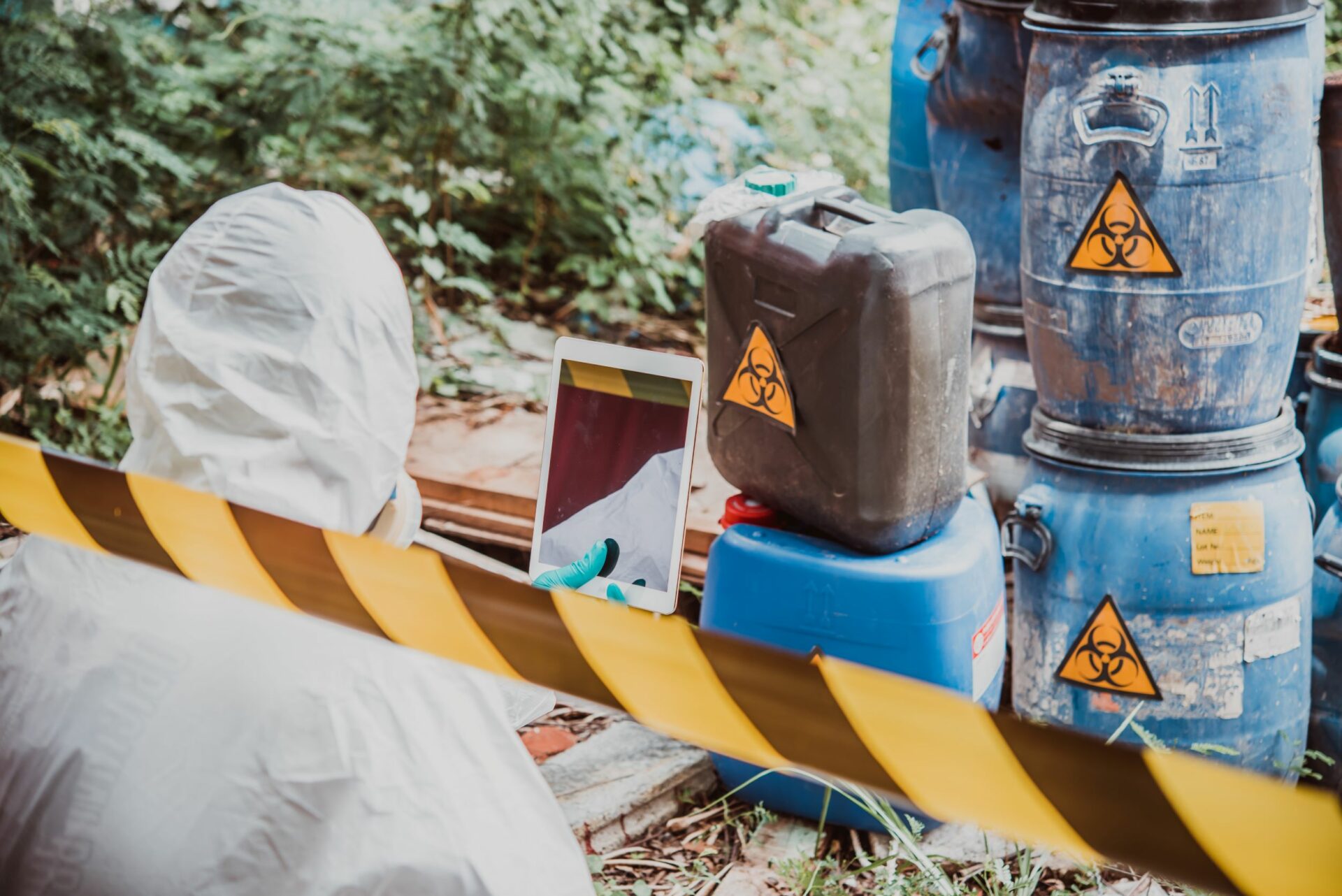Hazardous materials in the workplace can cause severe health problems and/or physical injury to the worker. Employers have the responsibility to anticipate, recognize, evaluate and control hazards associated with hazardous materials in the workplace. Hazard abatement must be accomplished through a hierarchy of controls. Hazardous materials can unexpectedly be brought home to a worker’s family, causing illness! There are many different classes of hazardous materials, but we will try to provide overall precaution when dealing with any type of hazardous material.
Multiple and varying definitions for the term “hazardous materials” can be found in different federal and state regulations. OSHA does not define the term, “hazardous materials,” in its Hazardous Materials standard, 29 CFR 1910 Subpart H, but rather refers to the following products for which the storage, handling, and use are regulated under the standard:
- Compressed gasses
- Acetylene
- Hydrogen
- Oxygen
- Nitrous oxide
- Flammable liquids
- Flammable materials used in spray finishing operations
- Explosive and blasting agents
- Liquefied petroleum gasses
- Anhydrous ammonia
- Highly hazardous chemicals
- Hazardous waste and exposure to substances during hazardous waste operations and emergency response
- Liquids used in dipping and coating operations
In the workplace, exposure to hazardous materials may come from the manufacturing, storage and/or process that uses or creates a situation as defined by the NFPA as being a hazardous (classified) location.
OSHA standards 29 CFR 1910, Subpart H lists requirements for the following situations, all of which have the potential to expose employees to hazardous materials:
- The proper use/storage of compressed gasses
- The proper use/storage of flammable liquids
- Spray finishing operations using flammable and combustible materials
- Storage and handling of liquefied petroleum gasses
- The process safety management requirements of highly hazardous chemicals (PSM)
- The work associated with hazardous waste operations and emergency response (HAZWOPER)
- Dipping and coating operations
- Working in confined spaces
When dealing with Hazardous Materials, there are physical hazards and there are health hazards.
Physical hazard means a chemical that is classified as posing one of the following hazardous effects: explosive; flammable (gasses, aerosols, liquids, or solids); oxidizer (liquid, solid or gas); self-reactive; pyrophoric (liquid or solid); self-heating; organic peroxide; corrosive to metal; gas under pressure; or in contact with water emits flammable gas.
Health hazard means a chemical which is classified as posing one of the following hazardous effects: acute toxicity (any route of exposure); skin corrosion or irritation; serious eye damage or eye irritation; respiratory or skin sensitization; germ cell mutagenicity; carcinogenicity; reproductive toxicity; specific target organ toxicity (single or repeated exposure); or aspiration hazard. When dealing with health hazards, there are 4 routes of entry to the body.
- Inhalation
- Ingestion
- Absorption
- Injection
Controlling Hazards
One of the main ways to control physical hazards associated with hazardous materials is through the use of ventilation. Since the air can contain flammable gas, ventilation is a good way to mitigate the gas levels. There are other measures that can be taken dependent on the specific material being worked with.
Public Safety
In case of an emergency involving hazardous materials:
CALL THE EMERGENCY RESPONSE Telephone Number on the Shipping Paper first. If the Shipping Paper is not available or there is no answer, refer to the appropriate telephone number listed on the inside back cover. As an immediate precautionary measure, isolate the spill or leak area in all directions for at least 50 meters (150 feet) for liquids and at least 25 meters (75 feet) for solids. Keep unauthorized personnel away and stay upwind. Keep out of low areas and ventilate closed spaces before entering.
For Evacuations for large spills consider initial downwind evacuation for at least 100 meters (330 feet).
For fires, if a tank, rail car or tank truck is involved in a fire, ISOLATE for 800 meters (1/2 mile) in all directions; also, consider initial evacuation for 800 meters (1/2 mile) in all directions.
For a small fire use water. Do not use dry chemicals or foams. CO2 or Halon® may provide limited control. For large fires, flood the fire area with water from a distance. Do not move cargo or vehicles if cargo has been exposed to heat. Move containers away from the fire area if you can do it without risk.
Spills and Leaks
Keep combustibles (wood, paper, oil, etc.) away from spilled material. Do not touch damaged containers or spilled material unless wearing appropriate protective clothing. Stop the leak if you can do it without risk. For a small dry spill, use a clean shovel to place material into a clean, dry container and cover loosely; move containers from the spill area.
First Aid
Common first aid steps include but are not limited to:
- Move the victim to fresh air
- Call 911 or emergency medical service
- Give artificial respiration if victim is not breathing
- Administer oxygen if breathing is difficult
- Remove and isolate contaminated clothing and shoes
- Contaminated clothing may be a fire risk when dry
- In case of contact with substance, immediately flush skin or eyes with running water for at least 20 minutes
- Keep the victim warm and quiet
- Ensure that medical personnel are aware of the material(s) involved and take precautions to protect themselves
Training
All HazMat employees must receive training and the training may be provided by the employer or private sources. Employers are required to ensure each HazMat employee is tested to certify their knowledge on Hazardous Materials Regulations. The training should include general awareness, function specific, driver and safety training. Training should be within 90 days of employment or assignment with refresher training every 2 years.
If you are looking for a comprehensive Hazardous Materials Safety Training, check out our DIY in-house training kit. Or check out our online training options. Feel free to give us a call with any questions about hazardous materials.
Call 866-627-3850 or email sales@jjsafetyllc.com to learn more.
